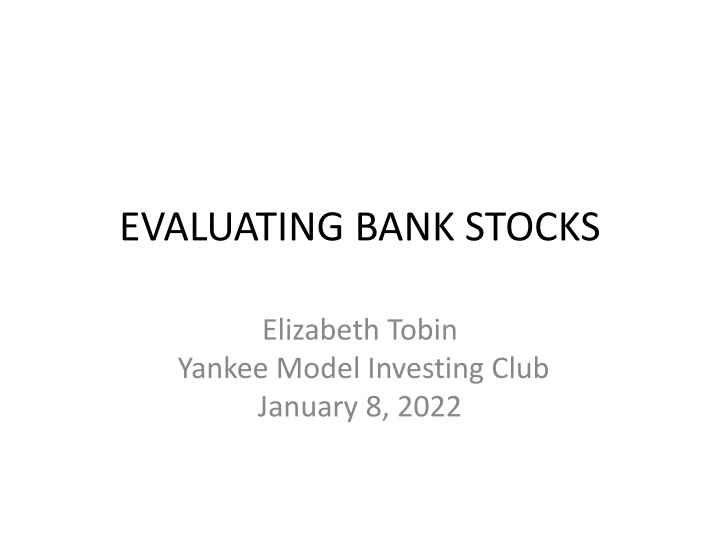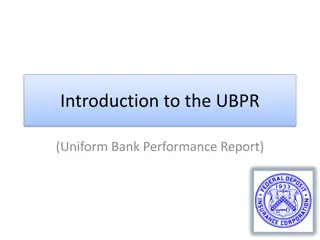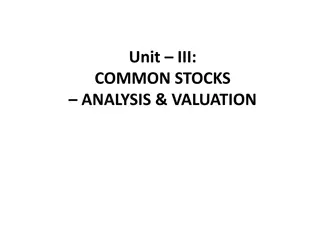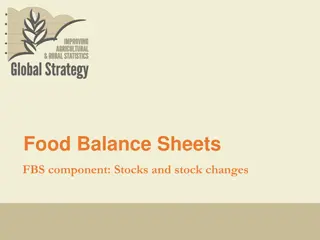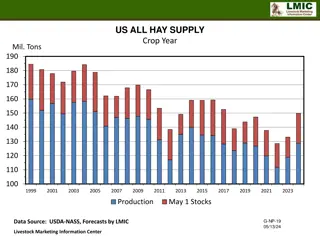Analyzing Bank Stocks for Profitable Investments
Explore key factors in evaluating bank stocks including revenue sources, expenses, loan quality, and growth metrics. Learn how banks make money, manage expenses, and maintain high-quality loan portfolios for sustainable growth and profitability. Discover the importance of efficiency ratios, interest spreads, and loan pricing in successful bank investments.
Download Presentation

Please find below an Image/Link to download the presentation.
The content on the website is provided AS IS for your information and personal use only. It may not be sold, licensed, or shared on other websites without obtaining consent from the author.If you encounter any issues during the download, it is possible that the publisher has removed the file from their server.
You are allowed to download the files provided on this website for personal or commercial use, subject to the condition that they are used lawfully. All files are the property of their respective owners.
The content on the website is provided AS IS for your information and personal use only. It may not be sold, licensed, or shared on other websites without obtaining consent from the author.
E N D
Presentation Transcript
EVALUATING BANK STOCKS Elizabeth Tobin Yankee Model Investing Club January 8, 2022
REFERENCES This presentation is based on the Better Investing 2017 seminar: Better Bank Stock Analysis Part 1by Ross Meredith Director of the Rocky Mountain Chapter Link to the Video: https://www.betterinvesting.org/members/learning- center/video-learning-library/stockup/better-bank- stock-analysis/better-bank-stock-analysis
SMALL? MEDIUM? OR LARGE? Small to Medium banks generally make money through loans funded by depositors Larger banks offer other services such as, trading, insurance and investment banking services This presentation will focus on loans and deposits
HOW BANKS MAKE MONEY Primary source of revenue is generated by interest on the loans the bank gives to customers Depositors fund these loans and the bank pays interest to its depositors Net Interest Spread a/k/a Net Interest Margin: difference between the interest rate the bank earns from loans and interest rate the bank pays for funding
LETS LOOK AT EXPENSES Overhead Expenses: all costs incurred other than the cost of funding facilities, staff, services, etc. Efficiency Ratio: % of how much of each dollar of new revenue goes to overhead Best banks maintain efficiency ratio of < 60%
TOTAL EXPENSES Overhead + Interest Rate Bank for Funding = Expenses Pricing Loans Is A Key Management Skill
LOAN QUALITY IS PRIMARY Maintaining a high quality portfolio of bank loans is a KEY MANAGEMENT SKILL. Bad loans are expensive; entire loan amount is lost, not just the interest. Loan Runoff is the portion of the bank s loans that are paid off every year. (Average loan runoff is 10% per year.) To increase revenue and income, a bank must increase it loans.
HIGH QUALITY US BANKS Lose less than 1% of loans to default per year. Grow assets at about 4 5% per year. Have actual growth, including replacement of paid off loans at 14-15% per year.
RECAP So far we know that the best bankers: Make good use of their deposits, a low cost source of funding Control their costs well Make good loans and price them well Achieve consistent growth of assets loans are a large portion of a bank s assets
TWO NUMBERS TO PINPOINT GOOD BANKS Loan Loss Provision the amount of loans the bank lost in the year is a good measure of the quality of the bank s loans Return on Average Assets (ROAA) measures the income the bank was able to earn after all expenses
MEASURING LOAN QUALITY Loan Loss Provision expense ratio is the amount of Loan Losses to amount of Total Loans to measure bank s ability to make good loans Calculate the ratio Loan loss provision expense Divided by Total loans If loan losses are well below 1% of loans for 8 10 years that s a good lender. In Value Line look for the box Loss Provisions. Divide it by Net Loans and it should be less than 1%
Return on Average Assets (ROAA) A good measure of profitability for a bank Defined as Net Income / Average Assets Average Assets = (Beginning year assets + Ending year assets) / 2 Quantifies management s ability to control expen ses and to maximize earnings from the assets We want banks that consistently exceed over 1% earned on assets Defined by Value Line as earnings divided by total assets (ROA)
WHATS A GOOD ROAA? As of 2017 the average bank earns a return on assets of about 0.79% Over 1.25% is good, only 9% of banks do that. Over 1.5% is VERY good, less than 4% of banks do that. A high ROAA is indicative of good management. ROAA Average is About 0.8% Good is Greater than 1.25% Excellent is Greater than 1.5%
Forecasting Future P/Es P/Es for banks, in general, tend to be low. Historical averages are often a good reflection of future P/Es for a high quality bank. Look at how the stock price performed in the Great Recession. Bank P/Es may be more sensitive to economic trends, including interest rates.
IN THE SSG Sales = Net Interest Income + Non Interest Income Total Assets is a line on the first page of SSG ROAA is included in SSG Plus
RESOURCES Better Investing Learning Center Better Bank Stock Analysis Parts 1&2 by Ross Meredith Director of the Rocky Mountain Chapter S&P Industry Survey Banks The Five Rules for Successful Stock Investing by Pat Dorsey Khan Academy (KhanAcademy.org) Search Subjects: Finance and Capital Markets, Money, Banking and Central Banks Banks Investor Relations Website FDIC.gov
